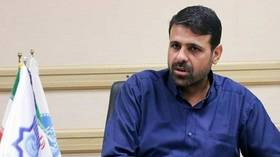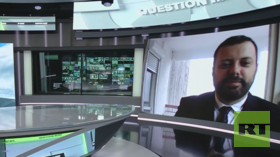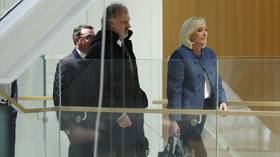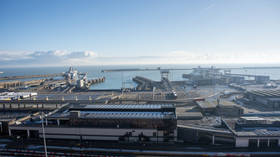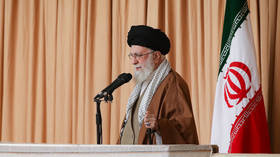Iranian protesters should be angry at the regime in Washington, not Tehran
The causes of Iran’s political unrest, unquestionably applauded by the usual suspects within the Trump administration, appears to be closely linked to Trump’s current maximum pressure campaign targeting the Islamic Republic.
Iran will always be a problem for the US as long as oil has a major part to play in the global economy. You may recall that Iran quietly announced last week the discovery of a new oil field in Gachsaran holding 54 billion barrels of oil (it is likely to hold more if the reservoir continues to the South). According to Oil Price, a source who works closely with Iran’s Petroleum Ministry has said that an operating unit of China National Petroleum Corporation (CNPC) will be a major stakeholder in the development of Iran’s gigantic new oilfield, Namavaran. No one will come right out and say it, but this is sure to sit badly with the US.
While recent reports of protests in Iran tend to focus on events as they happen in isolation, it may pay to look at the broader context in which these protests have erupted, and the underlying causes of this discontent.
Also on rt.com Beyond the price of gas: Iranian protests raise specter of regime changeThe cause of Iran’s economic deterioration is the implementation of US sanctions. What we are seeing is a tried and true strategy being implemented right across the board, including in places such as Venezuela. Sanctions are killing Venezuelan civilians, but we are all supposed to keep quiet about it lest we be labelled as “Maduro sympathizers” or whatever the popular phrase is nowadays.
The effects of Trump’s ‘maximum pressure’ campaign
Iran’s economy is reportedly at its worst since 1984. Its GDP is set to contract this year by 9.5%, according to data released by the IMF. Only Libya and Venezuela are predicted to perform worse than Iran by the end of the year (is it just me or are these three nations interconnected somehow?).
I also can’t help but notice that the protests in Iran appear to be following a domino effect from protests in Lebanon and Iraq, both of which were framed as bearing strong anti-Iranian sentiment.
Also on rt.com ‘Foreign-trained’ dual nationals among those arrested for stirring up violent fuel price riots – Iranian semi-official news agencyIn April 2018, Iran was exporting 2.5 million barrels of oil per day and beginning its acceptance into the global economy. In the last few months, this figure has been substantially reduced to perhaps as low as 160,000 barrels per day, bringing the economy to a near collapse. Inflation is rampant, with the cost of food, drinks, and tobacco rising by 60%. Unemployment numbers are also rising significantly, heavily affecting Iranian youths (40 percent of Iran’s population is under 25).
Last year, the International Court of Justice (ICJ) starkly warned the US that restrictions on the importation and purchase of goods required for humanitarian needs, including medicines, were having a “serious detrimental impact on the health and lives of individuals on the territory of Iran.”
You can picture my disbelief, therefore, when reading a recent op-ed by a Washington Post contributor who didn’t mention the impact of Washington’s “maximum pressure” campaign on Iran once… In fact, the author argues that the “eruptions are an objection to the regime’s inability to manage a financial crisis that Iranians believe is of its own creation.”
Iranian discontent: we’ve been here before
I genuinely think it’s dishonest not to highlight that Trump’s breach and complete disbandment of the Joint Comprehensive Plan of Action (JCPOA), followed by an intense sanctions regime, is the major driving force behind the poor state of Iran’s economy. If I recall, the US already did something similar to Iran once before, in 1953, shortly after Iran had democratically elected a leader who nationalized Iran’s oil. Taking a page right out of the US foreign policy cheat sheet, the US hit Iranian oil exports hard with the successful aim of publicly decreasing support for the Iranian leader (who was then ousted in a CIA-backed coup).
In 2017, in what can only be described as a continuation of a ghost from Iran’s past, the CIA named the ‘Dark Prince’ Michael D’Andrea, also known as Ayatollah Mike, to head the CIA’s Iran operations office. The fact that the CIA has an office set up solely to deal with Iran should tell you something about what we can expect from the CIA in the coming months or years.
And make no mistake: there are hints that the US is already involved in Iranian discontent in more ways than one. According to Bloomberg’s staunch anti-Iranian commentator, Eli Lake:
“The US government, meanwhile, is doing what it can… One US official tells me that the State Department has asked some of the big social media companies to suspend the accounts of Iranian regime leaders and entities as long as Iranian citizens are kept offline.”
Also on rt.com Iran-Iraq border crossing reportedly closed due to ongoing protests in both countriesIran is right to condemn US hypocrisy
Iran will have to decide how to deal with the protests while trying to minimize the international backlash, which is likely to take place irrespective, given reports are indicating significant numbers have been killed already. But this shouldn’t preclude us from examining America’s role in instigating this chaotic situation.
Even if American-enforced sanctions killed but one Iranian, that would surely be one Iranian too many. Otherwise, who are we to sit and judge the Iranian government, if the actions of our government detrimentally affect ordinary Iranians in the first instance? We can’t have it both ways.
Mike Pompeo might say he stands with the Iranian people, but history will remember that it was Pompeo and his cohorts who derailed Iran’s economy and sent the country into an abysmal downward trajectory.
Subscribe to RT newsletter to get stories the mainstream media won’t tell you.
The statements, views and opinions expressed in this column are solely those of the author and do not necessarily represent those of RT.







